History of the frigate USS Stark
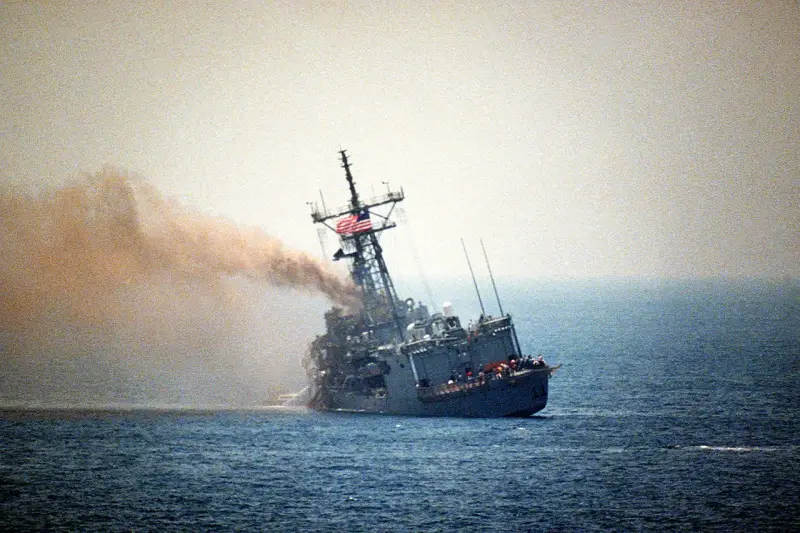
“look, this is new”;
but that was already centuries ago,
those who were before us."
Destroyers and aircraft carriers are circling in the Red Sea and its environs, planes are flying with bombs, and merchant ships are dodging missiles and UAVs attacking them with varying degrees of success. And from the shore they are threatened with all sorts of punishment by the Shiite paramilitary group known as the Houthis. But something similar already happened in the 1980s, when during the so-called “tanker war” US ships took Kuwaiti tankers under protection.
Let's look back at the very recent past and remember history frigate USS Stark. While reading VO, I came across references to it several times, and I got the impression that no one really knows what was there. That is, the result is known, but the details are, alas.
Reports
It turned out that the task is not so simple. It would seem that “the Internet remembers everything” - but not quite. He remembers, but too much time has passed, and many links, for example from Wikipedia, no longer work. You click on it, and the answer is “page not found”.
It turns out that as a result of the investigation, two reports were drawn up: one for the Navy, which was subsequently declassified, and the other for the Permanent Armaments Committee of the US Senate, the link to which is not recalled in any way. Whether there is a difference between them is unknown.
We managed to find two copies of the report for the Navy, which have a basic or brief footnote - that is, a shortened version. Both are 45 sheets long, both are heavily truncated, and one of them is in very poor condition. Both contain many blots and lacunae, and in different places. They complement each other well, but jumping from one to the other is tiring. Both have notes and footnotes for pages and appendices that are missing. For example, there are many references to pages with numbers greater than 45, and there are not a single map.
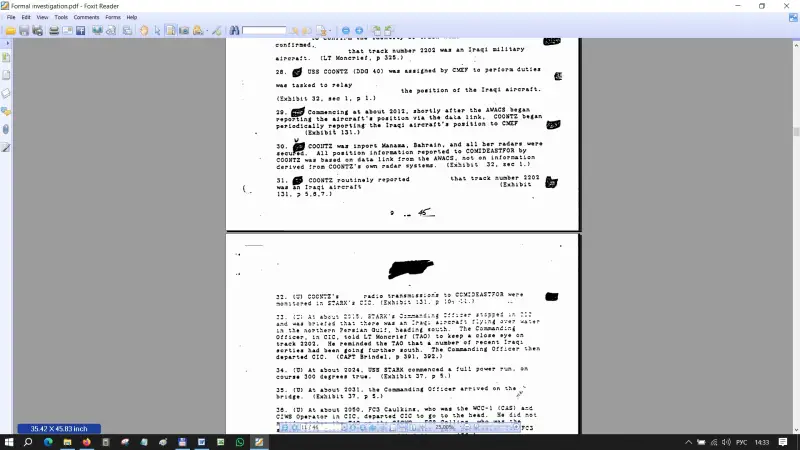
But let’s start, based on Formal Investigation Into the Circumstances Surrounding the Attack on the USS Stark on May 17, 1987. This paper was published on September 3, 1987 by the office of the Chairman of the Joint Chiefs of Staff. Still, this is an official statement, compiled on the basis of studying documents and interviewing actors, and everything is reflected there without emotion.
Participants
So, the participants of the events (this is from Wiki):
USS Stark: URO frigate (hereinafter simply frigate), the 23rd in a large series of Oliver Perry-class frigates. Entered service in 1982, displacement 4 tons, speed 200 knots, crew 29 people. We will not list the weapons; it will become clear during the course of the play.
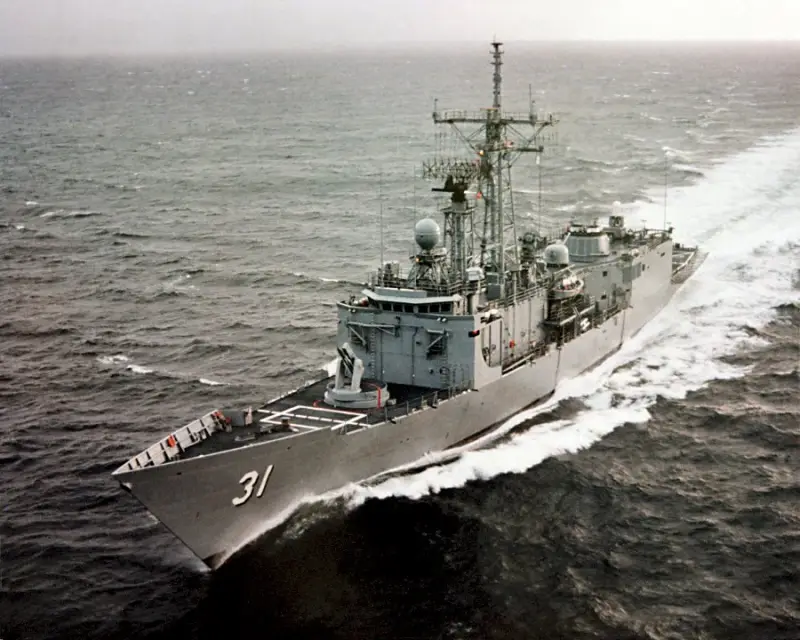
Dassault Mirage F1: single-seat French-made fighter, speed 2,2 M, ceiling 20 m, combat radius 000 km at a speed of 420 M. The Iraqi Air Force in the 0,75s received about 1980 Mirages in the F100EQ modification, which in turn had Several variants. More on this later.
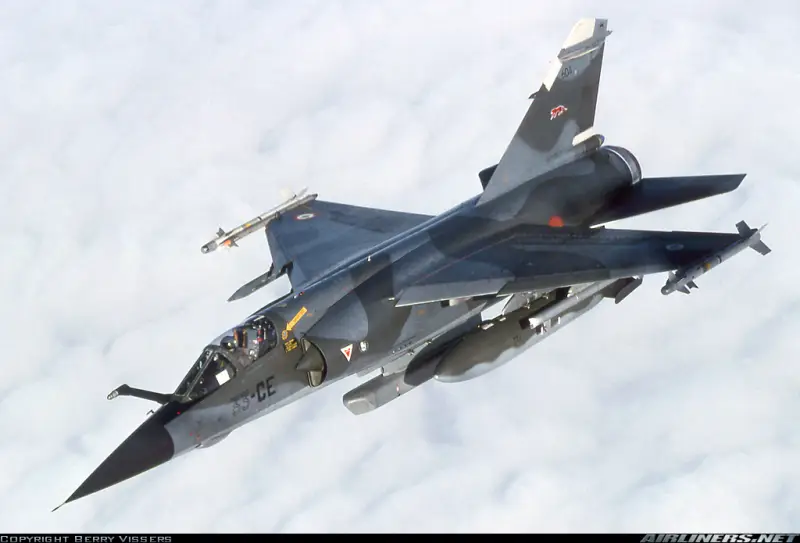
Dassault Falcon 50: a small 7-seat business jet made in France. Speed 0,7 5M, ceiling 15 m, range 000 km. The document doesn't say anything about it, but more on that later too.
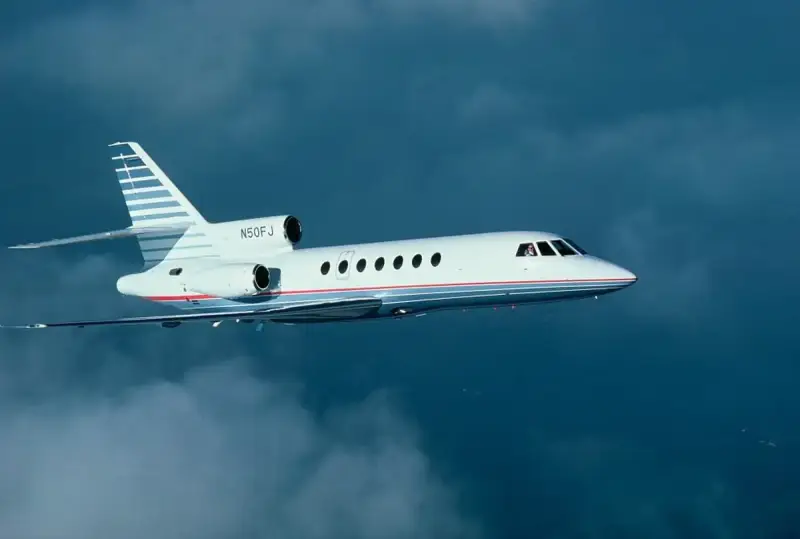
Exocet: French-made anti-ship cruise missile. Length 6 m, diameter 35 cm, weight 780 kg, of which 165 kg is the warhead, speed 0,93 M, range 70 km (in the AM39 version, which Iraq had).
USS Coontz: a rather old ship, built back in 1960, and soon after these events, in 1989, it was decommissioned. Its mission was to demonstrate the presence of the US Navy in the Gulf. During the events, he was in Bahrain and performed auxiliary functions, in particular duplicating the transmission of the AWCS aircraft. Subsequently, his emergency party participated in extinguishing the fire on the frigate.
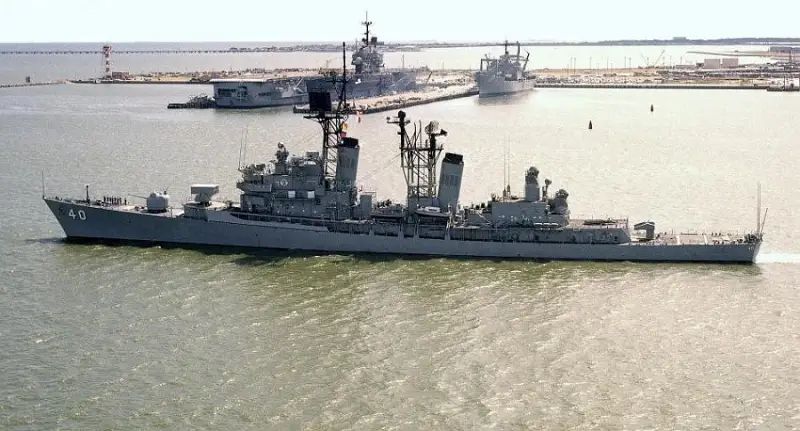
About weapons
To begin with, let’s talk very briefly about some of the weapons systems available on the frigate, so as not to be distracted by decoding later.
Anti-aircraft artillery weapons control system MK-92. It has its own radars, which are often mentioned in the document. There are two, and sometimes three, depending on the modification. These are an air surveillance radar, a water surface surveillance radar and a target illumination radar. The first two are combined into a common antenna post called CAS (Combined Antenna System) and are mandatory, and the third called STIR (Separate Target Illumination Radar) is an option. All have the ability to work in search, tracking and target highlighting mode. CAS range – 48 km, STIR range – 110 km. Obviously, the frigate's MK-92 system had all three radars.
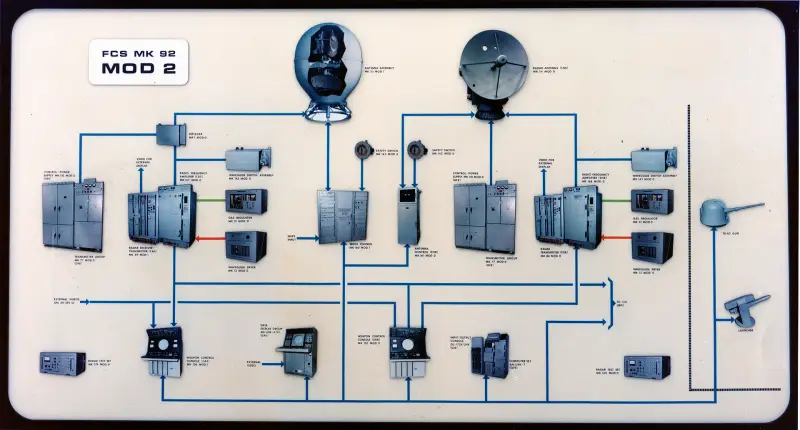
Further, the ship had a separate AN/SPS-49 radar for airspace monitoring. This is a separate system with an independent antenna that surveys the space, detects and classifies targets, and can serve as a backup radar for the control system weapons.
There was also an AN/SPS-55 radar for viewing the water surface, but it is not mentioned anywhere. Its antenna is very similar to those found on all merchant ships.
CIWS (Close-in Weapons System) is a close-in defense system. In theory, it should shoot down targets that have broken through all previous barriers. On the frigate, the well-known Phalanx Mark 15 acted in this capacity. I don’t give photos, there are plenty of them everywhere.
Mark36 SRBOC – installation for shooting dipole reflectors and infrared interference.
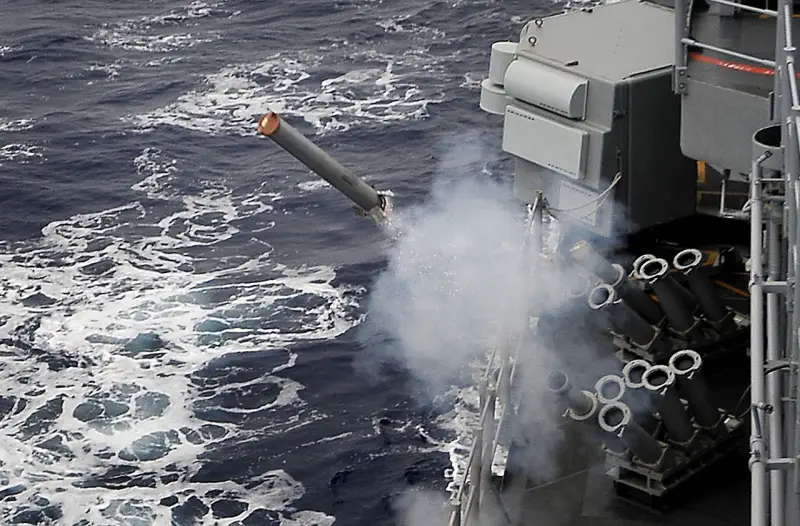
A short description of the events (this is from Formal Investigation).
Brief overview of events
On the evening of May 17, 1987, USS Stark, while on patrol in the central Persian Gulf, was hit by two Exocet missiles fired by a single Iraqi fighter taking off from Shaibach Air Force Base. The frigate at that moment was in international waters and away from the zones closed to navigation declared by Iraq and Iran.
An hour before the attack, an AWACS aircraft patrolling over the Gulf detected the takeoff of an Iraqi fighter, notified the frigate and continued to provide it with information via the NTDS Link 11 communications system about the aircraft's movements until the moment of the attack.
Contact was also made by the ship's AN/SPS-49 airspace control radar. 10 minutes before the first missile hit, radiation from the Cyrano IY radar, which is used for missile guidance and is equipped with Mirage fighters, was detected on the Stark frigate.
The frigate's combat information post (combat information post) continued to observe after contact was established and plotted the plane's course (apparently on a tablet). The Mirage changed course and speed several times, and each change brought it closer to the frigate. At a distance of 30 miles, the fighter turned east and headed directly for the frigate.
Five minutes later, the first missile hit the ship, and after another 30 seconds, the second.
As the fighter began to approach, the TAO (Tactical Action Officer) and others on duty assumed that the fighter would pass harmlessly within 11 miles of the frigate. The watchmen began collecting data in order to subsequently enter it into a special form about dangerous proximity, which they had to fill out and send to headquarters. The TAO officer did not consider the possibility that a fighter might attack the ship for no reason, although it was known that the Exocet missile could be launched from a range of 38 miles.
A few minutes before the attack, TAO tried to put the ship on high alert, but it was too late.
The responsibilities of CICWO (Combat Information Center Watch Officer) and WCO (Weapons Control Officer) were combined and entrusted to one officer. When the fighter began the attack, the WCO position was vacant, and when the officer arrived at the control panel, the aircraft had already fired both missiles.
The FCT (Fire Control Technician) crew member working with the MK-92 STIR radar and CIWS short-range defense system was absent for personal reasons (went to the latrine?), and at the time of the attack this place was also empty. The MK-92's STIR radar was in st-by mode (that is, ready for operation, but not operational), and was presumably obscured by the ship's superstructure.
The CAS radar of the same system was in search mode and was switched to target acquisition mode only a few seconds before the first missile hit. The Mark36 SRBOC unit was not charged, and the CIWS Phalanx system was in standby mode and was not switched to automatic mode.
At the time the missiles were launched, the only radars tracking the aircraft were AN/SPS-49 and MK-92 CAS. None of the target illumination radars were used.
The ship's commander was aware that an Iraqi fighter was flying in a southeast direction towards the center of the Persian Gulf. Approximately 50 minutes before the attack, he visited the BIP, where he was informed that an AWACS aircraft had reported a sighting of a fighter.
15 minutes before the attack, the commander was on the bridge and asked JOOD (Junior Officer Of the Deck) to find out why the destroyer USS COONTZ was reporting the coordinates of the fighter, but the frigate still did not see it on the radar. At this point, COONTZ provided the aircraft's position at intervals of 3–5 minutes.
Subsequently, reconstructing the events of that evening, the commander stated that the last known fighter position was located 120 miles north of the frigate. The commander was not aware that the frigate's BIP had established contact with the aircraft. At approximately 20:58 local time, the commander left the bridge and remained in the cabin until the first missile hit.
USS Stark did not use weapons or any countermeasures, either in self-defense or for the purpose of retaliation.
The attack and subsequent fire killed 37 people.
Further in more detail, with a description of the events and actions of various crew members.
Crew actions
Before commencing operations in the Gulf, the frigate's command received instructions from the headquarters of the Commander of American Forces in the Middle East (Comideastfor), located in Djibouti.
The briefing included:
– familiarization with intelligence information;
– information about potential threats to ships in the Gulf;
– rules for the use of weapons;
– information on how to identify the typical method of attack by Iraqi aircraft;
– data that the possibility of a deliberate attack on American ships is considered unlikely;
- a message that the ship’s commander not only has the right, but also the obligation to take all possible measures and precautions to protect the ship.
At the time of the attack, Stark was at point 26-47N/051-55E and was heading 300 degrees.
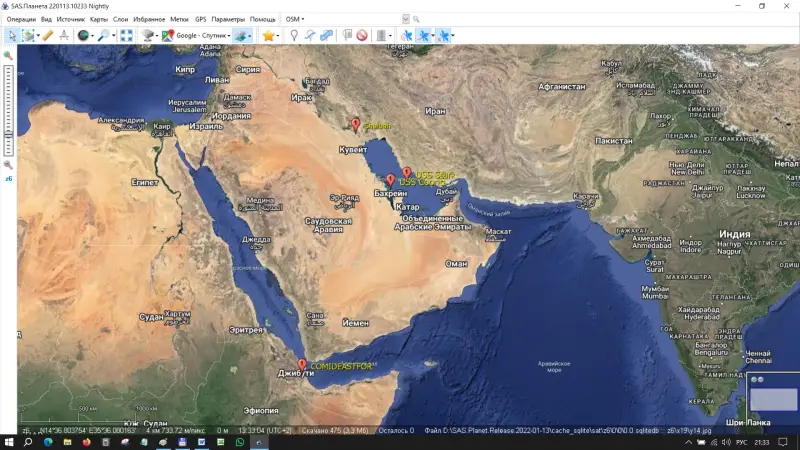
On duty at the CIC (Combat Information Center) were Lieutenant Moncrief as a TAO (Tactical Actions Officer), Ensign Wright as a CICWO (Combat Information Center Watch Officer) and at the same time a WCO (most likely this means Weapon Control Officer).
From the time the AWACS aircraft notified the frigate of the presence of the Iraqi aircraft until the first missile hit, the AWACS supplied the frigate (crossed out) with an NTDS communications link that provided the aircraft's current coordinates.
The track was assigned the number 2202 (there should be a map next, but it is crossed out).
Note. NTDS (Naval Tactical Data System) is both a BIUS and an associated information display protocol. Predecessor to the Aegis system.
The crew members on duty at the BIP (officer and enlisted men) were aware that... (crossed out - referred to an Iraqi military aircraft. It is possible that we are talking about track number 2202, but why cross it out? It is not clear. There is a footnote to the testimony of a certain OS1 (Operations Specialist 1 class) Duncan, but there is no page 101 with his testimony).
Approximately at 20:10 the frigate (crossed out, obviously, the last name) requested the AWACS aircraft to confirm the identity of the track of target 2202. AWACS confirmed that this data refers to an Iraqi military aircraft.
The destroyer USS Coontz was assigned to broadcast data transmitted by the AWACS aircraft, and starting from 20:12, shortly after the discovery of the Iraqi plane, periodically broadcast this data to the headquarters of the commander of American forces in the Middle East, located in Djibouti. The destroyer was in the port of Manama (Bahrain), and its radars were turned off. All the data it transmitted was a repeat of what the AWACS aircraft was transmitting. What the destroyer transmitted was also received by the frigate.
About 20:15 The frigate commander entered the BIP, where he was informed that an Iraqi fighter was flying in the northern part of the bay. The commander instructed the TAO to constantly monitor target 2202 and recalled that recently there had been flights of Iraqi aircraft in a southern direction.
About 20:24 the frigate gave full speed and set on a course of 300 degrees (why?).
В 20:31 the commander arrived on the bridge.
В 20:50 operator of the CAS radar and FC3 (Fire Controlman Third Class) close combat system Caulkins left the BIP, heading to the toilet (that's right!), without notifying the TAO. FC2 Collins, who was Fire Control's senior technician, allowed him to leave his post.
В 20:55 The commander, while on the bridge, asked the officer on watch why the BIP did not have a picture of the Iraqi aircraft on the radar, while the destroyer Qoontz regularly broadcast this data. There was a call from the bridge to the BIP with this question, to which OS1 Duncan, leaning over the shoulder of CS3 (Commissaryman Third Class) Renner, switched the SPS-49 air monitoring radar to (crossed out) mode. But in the other version of the report there is no blot - I switched to the range scale of 80 miles.
About 20:57, after the CCS (Combat Control System) officer reported that the full speed demonstration was short and not entirely successful (?), the commander left the bridge and went to his cabin.
20:58 headquarters, using the NBSV (Narrow Band Secure Voice system) system, asked all ships in the bay if they noted electromagnetic radiation or any other information indicating an attacking aircraft, and received a negative response. The AWACS aircraft noted that the Iraqi fighter had turned east.
Further, two lines have been crossed out, but from the next line it is clear that the watch at the BIP decided that the plane was passing safely at a distance of 11 miles from the current position of the ship.
21:00 operator CIC Vaughan reported to the bridge that he was observing a surface target at bearing 297, range 23 yards, speed 700 knots. Two minutes later, after checking with the CAS radar, the target was determined to be false.
21:01 OS1 Duncan, operating the ASAC (presumably stands for Airborne Surveillance and Control) console, picked up a radar blip (two lines crossed out) that he associated with target 2202, but marked it with a symbol meaning "unidentified target". He handed it over to OS3 Renner to continue tracking the new mark. He himself remained at the ASAC control panel and began preparing data for a report on a dangerous approach to the aircraft. From this point until the first missile hit, Renner continued to track the target on the SPS-49 radar.
21:02 Duncan reported to Lieutenant Moncrief that the target would miss the ship at a distance of 4 miles. At the same time, EW2 Kummrow (Electronic Warfare Technician 2 class) for the first time detected electromagnetic radiation (crossed out), characteristic of the CYRANO-IY radar, which is in service with the Iraqi Mirage F1 fighters.
21:03 the fighter was 43 miles from the frigate when Duncan requested permission from Lieutenant Moncrief to send the aircraft a standard warning on the military emergency frequency. The lieutenant replied, “no, wait.”
21:04 Lieutenant Commander Gajan, the frigate's XO, entered the BIP to discuss some administrative matters with Lieutenant Moncrief. Noticing that the lieutenant was busy, HO stopped at the table with a map and began to observe the work of the watch. At the same time, FC2 Collins (Fire-Controlman-Second-Class) sends OSSN Smith (Operational Support System Network) to find Caulkins who has gone into the latrine and return him to duty.
At the same time, the duty officer at the headquarters in Djibouti contacts the frigate and asks if they have information about target number 2202. Lieutenant Moncrief answers positively: yes, time 1802Z (what is this Z?), range 27 bearing 269, we are receiving a signal from CYRANO radar. We rate it as “Mirage F1”. This response came less than a minute after Coontz broadcast to headquarters that the Mirage was 38 miles from the frigate at bearing 269.
21:05 Iraqi F1 headed for the frigate. The distance to it was approximately 32,5 miles, and the CPA (Closest Point Of Approach) was approaching zero. No one in the BIP noticed this turn and the fact that the bearing to the plane was constant, and the distance was sharply reduced.
21:07, being at a distance of 22,5 miles from the frigate, the Mirage fired the first missile.
At the same time, the lookout SN (just a sailor) Williams noticed and reported a bright fire on the horizon at bearing 15 on the port side. This was originally defined as surface contact. At the same time, FC2 Collins noticed a blip on the CAS radar, which was in search mode, and decided that it was an Iraqi Mirage.
Still 21:07, Lt. Moncrief notices that the Mirage has changed course and its CPA will be very close to the frigate (in fact, the fighter had changed course a minute before). He orders OS1 Duncan to relay a warning to the aircraft and for Ensign Wright to call the captain. He calls the captain in the cabin - there is no answer, he calls the bridge - the captain is not there either.
Still 21:07. Moncrief orders Wright to take a seat at the WCO (Weapons Console Officer) console, but the first officer is sitting there. Wright asks to make room for him, sits down at the remote control, and turns it on. The system boot procedure begins.
21:08, the fighter fires a second missile, range approximately 15 miles.
Duncan, on the orders of the lieutenant, transmits on the emergency wave: unknown aircraft, this is a US warship at your (bearing) 78, distance 12, identify yourself.
His words go against the warning format prescribed by headquarters for a supposedly hostile aircraft - but let’s leave this to the conscience of the warning one.
Next comes a point that for some reason is completely missing from one of the report options.
21:08, EW2 Kummrow hears the CYRANO-IY radar enter target guidance mode. He increases the volume of the speaker on his remote, and this changed loud high-pitched sound is heard by everyone in the BIP post. All the watchmen turn to him. After about 10 seconds, the signal changes again, and its tone returns to its previous one. EWSN (didn't find what it is) Copus requests the lieutenant's permission to go on deck to charge the SRBOC jamming installation, receives permission, goes to the deck, charges the installation and returns to the BIP. Control of the installation is transferred to the CIC control panel.
By order of the lieutenant, Duncan issues a second warning to the plane, and again not according to the rules. It should be like this: Unidentified aircraft on heading __, speed __, altitude __, you are approaching a US Navy warship on heading __, range __. Your intentions are unclear, you are in danger and may be subject to defensive measures by a United States ship. Please stay away from me and immediately change course to __.
21:08, Lieutenant Moncrief approaches the CIWS (Clear Area Defense System) console, and Collins, sitting at the console, looks at him. None of them put the console into (crossed out) mode - but "automatic" is implied, because it further says: the CIWS system remained in st-by mode.
21:08, the lieutenant orders Collins to acquire the target with STIR radar. He replies that the Mirage is in the blind zone of this radar and recommends using the CAS radar. The lieutenant agrees, and the first officer, still present in the BIP, says: “let's show him who we are.” Obviously, no one yet realizes that the fighter has already used the weapon, everyone thinks that he simply turned on the targeting radar and then turned it off. Kind of intimidated.
21:09, lookout Williams shouts “missile inbound” over the loudspeaker. The watch officer on the bridge also sees the missile. At this moment, Collins nevertheless illuminated the Mirage with the CAS radar; the fighter was approximately 10 miles away.
21:09, Senior Officer Gajan radios to headquarters, “This is USS Stark, we’ve had target targeting radar used on us twice...” The transmission was interrupted.
The first missile hits the frigate.
Alarm signals are blaring in the premises, the watchman on the bridge sees a second missile and over the loudspeaker announces “missile, port side.”
21:09, Lieutenant Hayward, Support Officer (support officer - unclear), leaves the BIP and sees the captain leaving his cabin. The captain enters the BIP.
A second missile hits the frigate. The pause between hits is 30 seconds.
Weapons that the frigate could have used, but did not use:
– SM-1 MR missiles;
– MK75 gun with a caliber of 76 mm;
– CIWS Phalanx close-in protection system;
– '50 caliber machine guns;
– installation of shooting dipole reflectors and infrared interference SRBOC.
Now an addition.
Addition
You probably already forgot that among the participants in the events there was a completely civilian plane, and even one intended for transporting VIPs?
So, when the showdown began, the question suddenly arose - where did the second rocket come from?
Iraq had Mirage F1 fighters in the EQ-5 variant, which could carry only one Exocet missile, and the EQ-6 variant with two missiles.
But the EQ-6 variant had an upgraded Cyrano radar, the characteristics of which were slightly different from those installed on the younger version of the fighter. It is unknown which of them took part in the attack on the frigate.
But cunning journalists, most likely with connections in the intelligence community, subsequently unearthed that in fact the frigate was attacked by an upgraded Falcon-50, which was equipped with the same Cyrano radar as on the younger Mirages, and guides for two missiles. There is a whole book about this, and it is now considered an established fact.
That's all for now.
In the second part I will try to talk about the fire, the damage and the fight against it, as well as the conclusions of the investigation commission.
Information